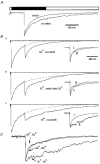Sr2+-dependent asynchronous evoked transmission at rat striatal inhibitory synapses in vitro
- PMID: 9852326
- PMCID: PMC2269087
- DOI: 10.1111/j.1469-7793.1999.447ae.x
Sr2+-dependent asynchronous evoked transmission at rat striatal inhibitory synapses in vitro
Abstract
1. At striatal inhibitory synapses in cell culture, replacement of extracellular Ca2+ with Sr2+ desynchronized inhibitory postynaptic currents (IPSCs), reducing their peak amplitude and producing a succession of late, asynchronous synaptic events (late release). In the averaged IPSC waveform this resulted in an increase in both the fast and the slow decay time constant as well as in the time to peak. 2. Rapid removal of extracellular Sr2+ during late release was without effect on the time course of the averaged IPSC. Thus, late release is not dependent on continuous Sr2+ influx, but must be related to the way in which Sr2+, as opposed to Ca2+, interacts with constituents of the intracellular space. 3. After application of the membrane-permeant acetoxymethyl ester (AM) form of the Ca2+-chelator BAPTA, Sr2+-induced late release was greatly reduced and the kinetics of the Sr2+-dependent IPSC approached those of the Ca2+-dependent response. EGTA AM had a similar but less pronounced effect. 4. Using rapid solution exchange, we stimulated synapses first in Sr2+- or Ca2+- and 100-300 ms afterwards in Ca2+-containing solution. Paired-pulse facilitation of late release was the same whether the conditioning pulse induced a presynaptic influx of Sr2+ or of Ca2+. 5. It is concluded that Sr2+-mediated asynchrony is probably due to a less efficient intraterminal buffering of Sr2+ as opposed to Ca2+, allowing for Sr2+ ions to activate release in an area less confined to the immediate vicinity of the presynaptic Ca2+ channel. This hypothesis explains both the action of endogenous buffers and the apparent lack of specific facilitatory interaction between Ca2+-mediated and Sr2+-induced late release.
Figures






Similar articles
-
Post-tetanic potentiation of GABAergic IPSCs in cultured rat hippocampal neurones.J Physiol. 1999 Aug 15;519 Pt 1(Pt 1):71-84. doi: 10.1111/j.1469-7793.1999.0071o.x. J Physiol. 1999. PMID: 10432340 Free PMC article.
-
A comparison between potencies of external calcium, strontium and barium to support GABAergic synaptic transmission in rat cultured hippocampal neurons.Neurosci Res. 1994 Sep;20(3):223-9. doi: 10.1016/0168-0102(94)90091-4. Neurosci Res. 1994. PMID: 7838423
-
Activity-dependent depression of GABAergic IPSCs in cultured hippocampal neurons.J Neurophysiol. 1999 Jul;82(1):42-9. doi: 10.1152/jn.1999.82.1.42. J Neurophysiol. 1999. PMID: 10400933
-
Sr2+ supports depolarization-induced suppression of inhibition and provides new evidence for a presynaptic expression mechanism in rat hippocampal slices.J Physiol. 1997 Dec 1;505 ( Pt 2)(Pt 2):307-17. doi: 10.1111/j.1469-7793.1997.307bb.x. J Physiol. 1997. PMID: 9423174 Free PMC article.
-
Mechanism of action and persistence of neuroprotection by cell-permeant Ca2+ chelators.J Cereb Blood Flow Metab. 1994 Nov;14(6):911-23. doi: 10.1038/jcbfm.1994.122. J Cereb Blood Flow Metab. 1994. PMID: 7929656 Review.
Cited by
-
Selective molecular impairment of spontaneous neurotransmission modulates synaptic efficacy.Nat Commun. 2017 Feb 10;8:14436. doi: 10.1038/ncomms14436. Nat Commun. 2017. PMID: 28186166 Free PMC article.
-
Ionic dependence of Ca2+ channel modulation by syntaxin 1A.Proc Natl Acad Sci U S A. 2002 Mar 19;99(6):3968-73. doi: 10.1073/pnas.052017299. Epub 2002 Mar 12. Proc Natl Acad Sci U S A. 2002. PMID: 11891287 Free PMC article.
-
Two forms of asynchronous release with distinctive spatiotemporal dynamics in central synapses.Elife. 2023 May 11;12:e84041. doi: 10.7554/eLife.84041. Elife. 2023. PMID: 37166282 Free PMC article.
-
Post-tetanic potentiation of GABAergic IPSCs in cultured rat hippocampal neurones.J Physiol. 1999 Aug 15;519 Pt 1(Pt 1):71-84. doi: 10.1111/j.1469-7793.1999.0071o.x. J Physiol. 1999. PMID: 10432340 Free PMC article.
-
Two GABAA responses with distinct kinetics in a sound localization circuit.J Physiol. 2012 Aug 15;590(16):3787-805. doi: 10.1113/jphysiol.2012.230136. Epub 2012 May 21. J Physiol. 2012. PMID: 22615438 Free PMC article.
References
-
- Behrends JC, ten Bruggencate G. Changes in quantal size distributions upon experimental variations in the probability of release at striatal inhibitory synapses. Journal of Neurophysiology. 1998;79:2999–3011. - PubMed
-
- Borst JGG, Sakmann B. Calcium influx and transmitter release in a fast CNS synapse. Nature. 1996;383:431–434. - PubMed
Publication types
MeSH terms
Substances
LinkOut - more resources
Full Text Sources
Miscellaneous

